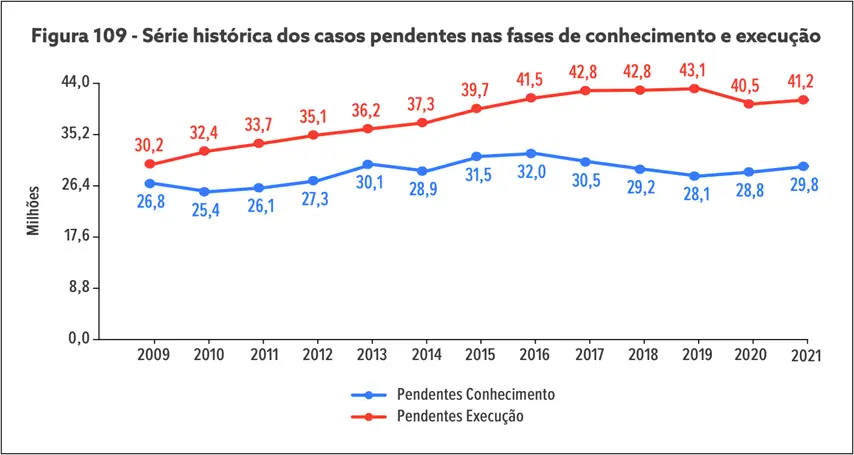
iNVESTIGAÇÃO PATRIMONIAL
Investigação e consultoria de excelência para encontrar patrimônio, identificar teses vencedoras e auxiliar na resolução do caso.
Hoje o maior gargalo da Justiça é justamente a execução civil, ou seja, a parte de cobrar dívidas inadimplidas, seja em razão de contratos, condenações judiciais ou outras obrigações que gerem o dever de pagar.
Segundo o relatório Justiça em Números de 2022, “o Poder Judiciário contava com um acervo de 77 milhões de processos pendentes de baixa no final do ano de 2021, sendo que mais da metade desses processos (53,3%) se referia à fase de execução” . Isso significa impressionantes 41,2 milhões de execuções pendentes!
Em muitos processos isso acontece porque o devedor de má-fé –, ou seja, aquele que tem patrimônio para pagar as dívidas, mas não as paga porque não quer – possui ao seu dispor uma série de mecanismos extrajudiciais de blindagem patrimonial, e grande parte desses mecanismos são muito rápidos de serem utilizados, estando há poucos cliques de distância.
Por isso há uma percepção geral frustrante de que o credor só tem os instrumentos processuais (que são bastante lentos) ao seu dispor para pedir os bens do devedor; já o devedor que estiver de má-fé pode se valer de providências extraprocessuais que por sua vez são bastante rápidos e frustram aqueles pedidos do credor.

Figura 1 – fonte: CNJ. Disponível em: https://www.cnj.jus.br/wp-content/uploads/2022/09/justica-em-numeros-2022.pdf – acesso em: 24 nov. 2022.
Essas providências de alguns devedores podem incluir esvaziar contas, transferir seus ativos para terceiros em conluio – os conhecidos “laranjas” –, constituir empresas de fachada, continuar a atividade em outro CNPJ, vender seus bens para terceiros de boa-fé, entre outras providências que frustram o credor.
Mas não precisa ser assim.
A providência que mais equaliza essa relação e pode dar efetividade a esses processos é a investigação patrimonial bem-feita.
A investigação patrimonial diminui enormemente a desvantagem do credor diante do devedor de má-fé que age extrajudicialmente. Grande parte das pesquisas em uma investigação bem-feita também é extrajudicial, e servem como subsídio para que o credor possa ter depois uma atuação processual muito mais assertiva, rápida e, portanto, efetiva.
A investigação é essencial para colocar luz no patrimônio do devedor; revelar os bens penhoráveis, descobrir as eventuais fraudes que possam estar acontecendo e assim possibilitar uma cobrança exitosa e bem-sucedida.
Seja antes da execução civil ou da cobrança judicial começar; seja no seu decorrer ou ainda depois de muito tempo quando o processo já se arrasta por vários anos, em qualquer momento a investigação patrimonial pode gerar muito valor para o credor e dar lícitas e poderosas armas para seu advogado.
A informação obtida extrajudicialmente, além de ter grande valor por si só, muitas vezes justifica perante o juiz o uso de outras medidas investigativas ou coercitivas mais arrojadas que ele pode determinar.
E, melhor do que isso, muitas vezes, o poder da informação obtida nessas investigações é tão grande que o caso é resolvido com um acordo extrajudicial, sem sequer necessitar que tais descobertas sejam levadas “ao fórum”, como se diz.
Mas é importante que a investigação patrimonial seja realizada por profissionais especialistas nisso. Isso porque ela deve acontecer de forma lícita, tendo justa causa compatível com a LGPD, e somente pode ter como objeto fontes de dados públicas e abertas. É preciso saber o que fazer, onde fazer, quando fazer, porque fazer e, claro, como fazer.
Há vários métodos possíveis.
E, como exemplo…
Nós desenvolvemos uma metodologia única de três etapas que dá o máximo de eficiência para as investigações patrimoniais, obtendo o maior resultado no menor tempo e com o menor custo, e sempre participando o interessado e sua equipe de profissionais das decisões tomadas ao longo do caminho.
Nossa metodologia de investigação patrimonial é única
Nós desenvolvemos uma metodologia única de três etapas que dá o máximo de eficiência para as investigações patrimoniais, obtendo o maior resultado no menor tempo e com o menor custo, e sempre participando o interessado e sua equipe de profissionais das decisões tomadas ao longo do caminho.

ETAPA 1
A Etapa 1 foca no que chamamos de pesquisa preliminar, onde com a ajuda das ferramentas mais avançadas do mercado disparamos uma série de buscas sobre as pessoas pesquisadas, identificando desde logo grupos econômicos, empresas, sócios, pessoas relacionadas, notícias, mídias sociais, imóveis, localidades de atuação, marcas e patentes no INPI, processos judiciais, licitações, atos societários e tantas outras informações que geram imediatamente muito valor para o interessado e abrem o universo e o ecossistema do caso.

ETAPA 2
A Etapa 2 é focada na aquisição de documentos. Uma vez finalizada a Etapa 1 são identificados uma série de documentos que precisam ser adquiridos para esclarecerem a situação jurídica e patrimonial da pessoa pesquisada. Nesse momento é preciso fazer uma seleção cuidadosa dos documentos que serão relevantes e daqueles que não serão relevantes, e depois adquiri-los de uma forma eficiente e organizada, para que possam ser depois tratados da maneira devida.

ETAPA 3
A Etapa 3, por fim, coroa toda a metodologia e consiste na análise dos documentos e elaboração das teses que poderão resolver o caso. Nessa etapa tudo o que apareceu no caso é tratado, e todos os documentos adquiridos são lidos e analisados, e as teses e descobertas reunidas em um dossiê, tudo com o objetivo de encontrar uma solução para o caso, revelar bens penhoráveis, revelar as fraudes eventualmente cometidas, e, por assim dizer, trazer as informações fundamentais para “desblindar” o patrimônio.
Com isso em mãos, o credor e o advogado responsável terão fatos e estratégias poderosas que poderão solucionar o caso.
DEPOIMENTOS
Preencha seus dados para que um especialista entre em contato:

Copyright © 2025 Prof Rommel Andriotti. Todos os Direitos Reservados.